
Warning: file_put_contents(./cache/6_nopy.txt): failed to open stream: Permission denied in /data/clients/davidhoustin/chinese.gratis/www/method/index.php on line 275
Chinese numbers - Lesson 06
Chinese numbering is much easier to learn and understand than in French; indeed, there is no complicated composition like in that language.


1. Numbers 0 to 10
| Number | Chinese | Pinyin | |
| 0 ; zero | 零 / 〇 | líng | |
| 1 ; one | 一 | yī | |
| 2 ; two | 二 | èr | |
| 3 ; three | 三 | sān | |
| 4 ; four | 四 | sì | |
| 5 ; five | 五 | wǔ | |
| 6 ; six | 六 | liù | |
| 7 ; seven | 七 | qī | |
| 8 ; eight | 八 | bā | |
| 9 ; nine | 九 | jiǔ | |
| 10 ; ten ; tenth | 十 | shí |

2. Multiples of 10
The multiple of 10, up to 90, are easy to form since we take the multiplier number to which we add "10" 十 ‹ shí ›.
| Number | Chinese | Pinyin | |
| 20 ; twenty | 二十 | èr shí | |
| 30 ; thirty | 三十 | sān shí | |
| 40 ; forty | 四十 | sì shí | |
| 50 ; fifty | 五十 | wǔ shí | |
| 60 ; sixty | 六十 | liù shí | |
| 70 ; seventy | 七十 | qī shí | |
| 80 ; eighty | 八十 | bā shí | |
| 90 ; ninety | 九十 | jiǔ shí |

3. Counting up to 99
To count from 11 to 99, just take one of the multiple of 10 seen above and add a number between 1 and 9.
Few examples :
| Number | Chinese | Pinyin | |
| 11 ; eleven ; (10 + 1) | 十一 | shí yī | |
| 12 ; twelve ; (10 + 2) | 十二 | shí èr | |
| 13 ; thirteen ; (10 + 3) | 十三 | shí sān | |
| 24 ; twenty-four ; (2 x 10 + 4) | 二十四 | èr shí sì | |
| 38 ; thirty-eight ; (3 x 10 + 8) | 三十八 | sān shí bā | |
| 45; forty-five ; (4 x 10 + 5) | 四十五 | sì shí wǔ | |
| 55 ; fifty-five ; (50 x 10 + 5) | 五十五 | wǔ shí wǔ | |
| 63 ; sisty-five ; (6 x 10 + 3) | 六十三 | liù shí sān | |
| 72 ; seventy-two ; (6 x 10 + 2) | 七十二 | qī shí èr | |
| 81 ; eighty-one ; (8 x 10 + 1) | 八十一 | bā shí yī | |
| 99 ; ninety-nine ; (9 x 10 + 9) | 九十九 | jiǔ shí jiǔ |

4. Four types of units
In addition to "10" 十 ‹ shí ›, there are four other unit categories to count beyond 99, 999, 9.999 and over.
| Chinese | Pinyin | Translation | |
| 百 | bǎi | hundred (100) | |
| 千 | qiān | thousand (1.000) | |
| 万 | wàn | ten thousand (10.000) | |
| 亿 | yì | hundreds of millions (100.000.000) |

5. Large numbers
Like for the tens numbers, to compose large numbers, we place before one of the four unit types a multiplier number from 1 to 9.
| Translation | Chinese | Pinyin | |
| 100 ; one hundred | 一百 | yī bǎi | |
| 200 ; two hundred | 二百 | èr bǎi | |
| 1.000 ; one thousand | 一千 | yī qiān | |
| 3.000 ; three thousand | 三千 | sān qiān | |
| 9.999 | 九千九百九十九 | jiǔ qiān jiǔ bǎi jiǔ shí jiǔ | |
| 10.000 ; ten thousand | 一万 | yī wàn | |
| 40.000 ; forty thousand | 四万 | sì wàn | |
| 100.000 ; one hundred thousand; (10 x 10.000) | 十万 | shí wàn | |
| 500.000 ;five hundred thousand | 五十万 | wǔ shí wàn | |
| 1.000.000 ; one million ; (100 x 10.000) | 一百万 | yī bǎi wàn | |
| 6.000.000 ; six million | 六百万 | liù bǎi wàn | |
| 10.000.000 ; ten million (1.000 x 10.000) | 一千万 | yī qiān wàn | |
| 70.000.000 ; seventy million | 七千万 | qī qiān wàn | |
| 100.000.000 ; one hundred million | 一亿 | yī yì | |
| 800.000.000 ; eight hundred million | 八亿 | bā yì | |
| 1.000.000.000 ; one billion ; (10 x 100.000.000) | 十亿 | shí yì |
- 108 = 一百〇八 ‹ yī bǎi líng bā ›
and not 一百八 - 10.050.082 = 一千〇五万〇八十二 ‹ yīqiān líng wǔwàn líng bā shí èr ›
and not 一千五万八十二 - 1.006 = 一千〇六 ‹ yī qiān líng liù ›
and not 一千六 ou 一千〇〇六
Should you wish to venture further by training yourself or simply wish to translate large number, you can use our numbers and dates online translator.

6. Years, phone n°, ...
- For number enumerations like a phone number, the Chinese often replace 一 by 幺 ‹ yāo › in spoken.
- (year) 2014 = 二〇一四(年) ‹ èr líng yī sì (nián) ›
and not 二千〇一十四

7. Number with hand signs
The Chinese do not use the same hand signs for counting than we do, or to confer a number between 1 and 10. In fact, our "2" for example may look like the Chinese "8". In addition, the number 10 may vary according to the region.




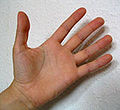

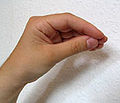
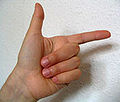


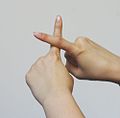
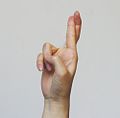

Possession and classifiers





